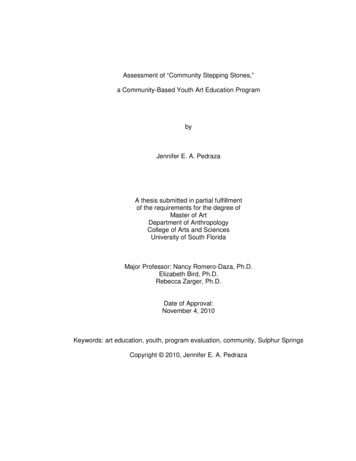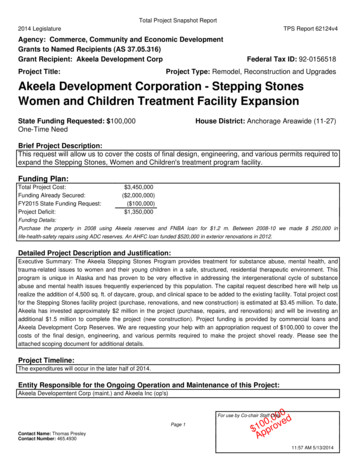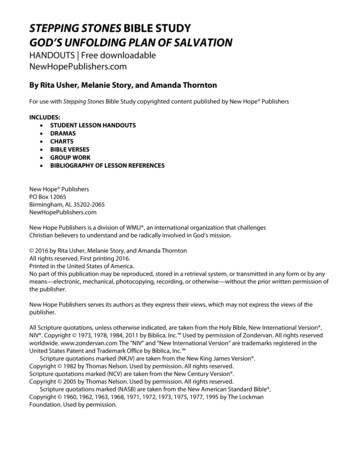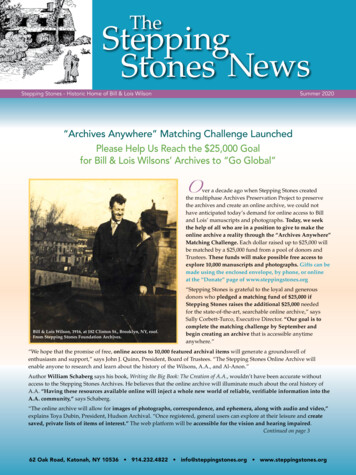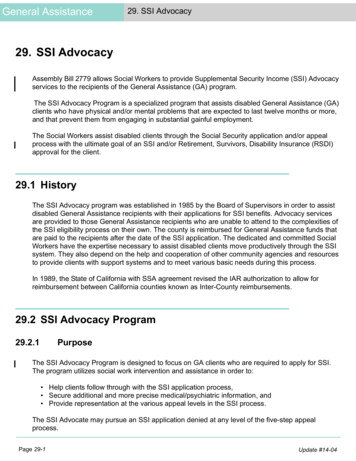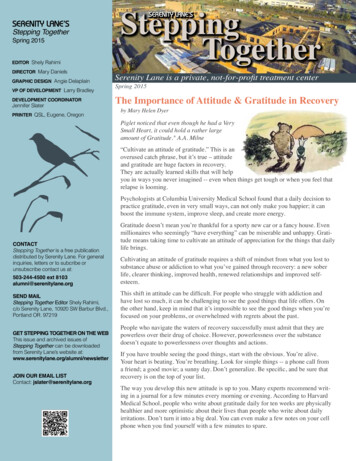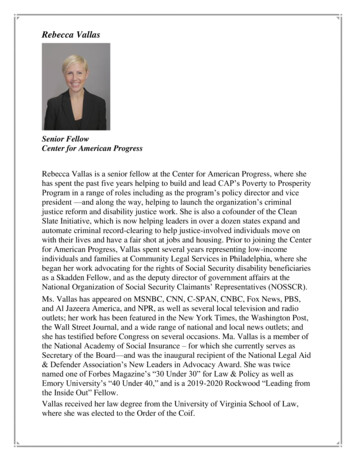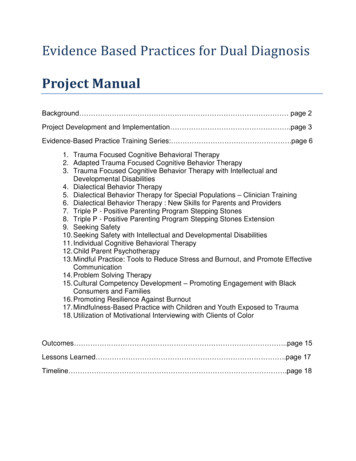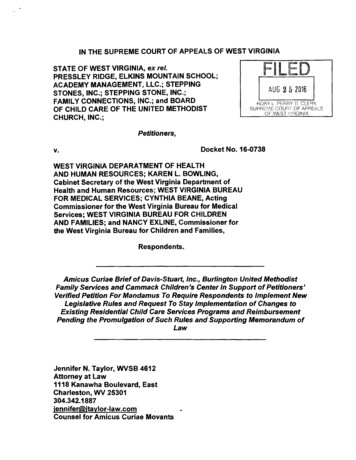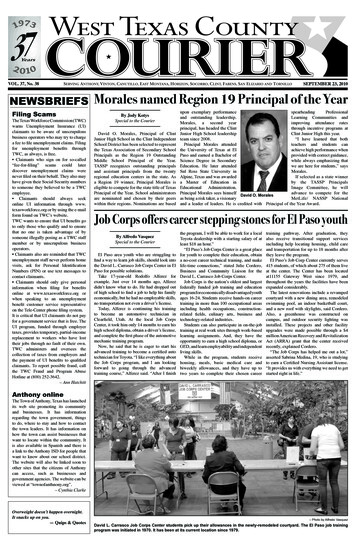
Transcription
Stepping Stones to SSI and SSDIA Training Curriculum for Case ManagersAssisting Adults with HIV/AIDS with SocialSecurity Disability and Supplemental SecurityIncome ApplicationsPARTICIPANT GUIDEJune 2009Office of HIV/AIDS Housing
ACKNOWLEDGEMENTSStepping Stones to SSI and SSDI: A Training Curriculum for Case Managers Assisting Adults withHIV/AIDS with Social Security Disability and Supplemental Security Income Applicationswas adapted by the authors from a curriculum developed for the Substance Abuse and Mental HealthServices Administration (SAMHSA). This curriculum, entitled Stepping Stones to Recovery: ATraining Curriculum for Case Managers Assisting Adults Who Are Homeless with Social SecurityDisability and Supplemental Security Income Applications, focused on assisting people experiencinghomelessness who had serious mental illnesses and/or co-occurring substance use disorders.Numerous people contributed to the adaptation of this curriculum. This document was written byYvonne Perret of the Advocacy and Training Center and Deborah Dennis, Margaret Lassiter andJackie Massaro from Policy Research Associates.The authors would like to thank to the members of the HOPWA Focus Group, (See For MoreInformation tab), who reviewed and commented on an earlier draft. Their input was invaluable inshaping this curriculum.DisclaimerThe views, opinions, and content of this publication are those of the authors and do not necessarilyreflect the views, opinions, or policies of the Housing Opportunities for Persons with AIDS,U.S.Department of Housing and Urban Development, the Substance Abuse and Mental Health ServicesAdministration (SAMHSA), U.S. Department of Health and Human Services (HHS), or the SocialSecurity Administration.Recommended CitationPerret, Y., Dennis, D., Lassiter, M., & Massaro, J. (2009). Stepping Stones to SSI and SSDI: ATraining Curriculum for Case Managers Assisting Adults with HIV/AIDS with Social Security Disabilityand Supplemental Security Income Applications (1st ed.). Delmar, NY: Policy Research Associates.
Stepping Stones to SSI and SSDIJune 2009ConTENTSIntroductionModulesOpeningModule 1Module 2Module 3Module 4Module 5Module 6Module 7Module 8Module 9Module 10Module 11Module 12Module 13Module 14Module 15ClosingThe Disability Programs of the Social Security AdministrationEngaging the Applicant Who Has HIV/AIDSThe Application Process: Non-Medical InformationThe Application Process: Medical InformationEligibility Criteria and the Sequential EvaluationMedical Information on HIVCo-Occurring DisordersCollecting the Medical Evidence: The Usual ProcessThe New and Improved ProcessInterviewing and AssessingFunctional InformationWriting Functional DescriptionsThe Full Picture: The Medical Summary ReportSupplemental Medicaid Programs: QMB, SLMB, and QI-1Work, Work, WorkAdditional SSA Disability Application FormsSample Medical Summary ReportsVideo Simulated InterviewGlossaryFor More InformationContributorscontentsiii
Stepping Stones to SSI and SSDIJune 2009IntroductionThe Stepping Stones to SSI and SSDI curriculum focuses on assisting eligible adults whohave HIV/AIDS to access Social Security Administration disability benefits. These benefitsinclude Supplemental Security Income (SSI) and Social Security Disability Insurance (SSDI)programs. These two national programs are the main income and health insurance for peoplewith disabilities. Importantly, the purpose of this curriculum is not to make all adults withHIV/AIDS eligible, but rather to help adults who are eligible to access them in an expeditedfashion.Since the beginning of the acquired immunodeficiency syndrome (AIDS) epidemic in the early1980s, many individuals living with the disease have had difficulty finding affordable, stablehousing. As individuals live with the demands of this disease, they may find themselves unableto work, while at the same time facing health care expenses that leave few resources to payfor housing. It is estimated by The National AIDS Housing Coalition that 70 percent of thoseliving with HIV/AIDS are at risk for homelessness. For this reason, and because people whoare homeless have extreme difficulty fully accessing life-prolonging care, Congress establishedthe Housing Opportunities for Persons With AIDS (HOPWA) program in 1992. HOPWA isadministered by the Office of HIV/AIDS Housing in the United States Department of Housingand Urban Development (HUD).Currently, HUD’s Office of HIV/AIDS Housing works with a network of 200 grantees and850 project sponsors to deliver housing support to low income households that include personsliving with HIV/AIDS. In 2008 HOPWA grantees reported that local efforts assisted 62,210households with housing support. The majority of program beneficiaries are extremelylow-income households, less than 30 percent of median income, and grantees report that 91percent have incomes below 1,000 per month. The HOPWA program provides direct housingassistance that supports unmet housing needs through the provision of rental assistance, the useof short-term rent, mortgage and utility payments to reduce risks of homelessness, and throughthe operation of supportive housing facilities.The Office of HIV/AIDS Housing reports that receiving SSI and/or SSDI is very beneficial forextremely low-income persons with HIV/AIDS. The modest income from these SSA programsmakes it possible to obtain housing, supportive services, and access to medical care. Sincemany HUD supportive housing programs require a tenant contribution of 30 percent of thetenant’s income, SSI or SSDI benefits would provide HOPWA with some revenue to offsetprogram costs and, thereby, allow HUD to serve more individuals.introduction1
Stepping Stones to SSI and SSDIJune 2009With this in mind, HOPWA has contracted for the adaptation of the Department of Health andHuman Services’ SSI/SSDI Outreach, Access and Recovery (SOAR) program into a HOPWASOAR initiative. It is HUD’s hope that, by facilitating an expedited SSA approval process,HOPWA residents with HIV/AIDS can quickly receive benefits and obtain the housing andsupportive services necessary to sustain a long and beneficial life.The Stepping Stones to SSI and SSDI curriculum rests on the collaboration of providers andother stakeholders to effectively serve adults with HIV/AIDS. The curriculum provides anin-depth step-by-step explanation of the application and disability determination process. Acompanion manual that was originally developed for the Federal Substance Abuse and MentalHealth Services Administration (SAMHSA) provides additional technical information and canbe accessed on the SOAR website (http://www.prainc.com/soar).In developing the modules for this curriculum, the authors recognize that many people withHIV/AIDS may be found disabled on a combination of illnesses, including mental health, otherphysical health problems, and co-occurring substance use disorders. This curriculum attemptsto provide the tools to develop claims for those who have complex challenges. Each modulebuilds on the preceding modules. Trainers and participants can spend more or less time onthe modules depending on their proficiency with the information. Exercises and worksheetsprovide practice opportunities and tools to assist with the application process. Additionalsamples of reports, letters, assessment tools, and SSA forms can be found at the end of eachmodule. A video offers a role-played assessment with a woman who is applying for benefitsbased primarily on a serious mental illness.The Stepping Stones to SSI and SSDI Participant Guide is not a stand-alone document. It isintended for use only after attending a Stepping Stones to SSI and SSDI training, led by anexperienced trainer who has attended a Stepping Stones to SSI and SSDI Train-the-Trainerprogram.Lastly, the model and information included in this curriculum are effective for use withindividuals who have a variety of disabilities. The focus of the curriculum is adults (accordingto SSA regulations, these are individuals who are 18 years of age or older) who havedisabilities related to HIV/AIDS. At the same time, the authors recognize that people do notfit into narrowly defined categories. Therefore, in addition to examples relating to HIV/AIDS,there are some relating to mental and other physical health difficulties.The ModulesThe Stepping Stones to SSI and SSDI curriculum was adapted from Stepping Stones toRecovery: A Training Curriculum for Case Managers Assisting Adults Who Are Homeless withSocial Security Disability and Supplemental Security Income Applications, developed by theSubstance Abuse and Mental Health Services Administration (SAMHSA).Opening: Setting the Stage This module opens the program and sets the stage for theunfolding of the content. It also outlines community collaborations necessary for starting aHOPWA SOAR initiative.Module 1: The Disability Programs of the Social Security Administration (SSA) gives anoverview of the two SSA disability programs discussed in the curriculum. It focuses primarily2Introduction
Stepping Stones to SSI and SSDIJune 2009on the basic differences and similarities between the two programs and introduces some of theterms used by SSA.Module 2: Engaging the Applicant Who Has HIV/AIDS introduces several strategies toengage an applicant as well as a technique of interviewing that creates a comfortable situationfor individuals who are revealing the private details of their lives. It also introduces somepotential roles that a case manager may play in the SSI/SSDI process.Module 3: The Application Process: Non-Medical Information describes the non-medicalapplication process, including the agencies that assess an application, the forms that arerequired, and the information that is needed. Special attention is given to critical sections of theSSI application: immigration, living arrangement, and income/resources. It also discusses thepros and cons of different application methods (in-person, by phone, online).Module 4: The Application Process: Medical Evidence focuses on the medical informationthat must be gathered and assessed for an SSI or SSDI application (especially for thecompletion of the SSA–3368 Disability Report and the SSA-4814 Medical Report for Adultswith HIV/AIDS). It stresses the medical evidence and its importance in the determinationprocess in particular. Presumptive disability for people with HIV/AIDS is also discussedbriefly.Module 5: Eligibility Criteria and the Sequential Evaluation presents the criteria thatthe Disability Determination Service (DDS) must consider when determining an applicant’seligibility. It discusses the process used for the determination called sequential evaluation.Module 6: Medical Information on HIV and the “Listings” provides training participantswith a general introduction to the Disability Evaluation Under Social Security (also called the‘Blue Book’ or the ‘listings’) with which the DDS evaluates impairment resulting from illness.It presents information regarding working with individuals and presenting medical informationfor people who have specific HIV/AIDS-related opportunistic diseases and provides anoverview of the listing for mental illnesses.Module 7: Co-Occurring Disorders discusses the challenges of evaluating and documentingco-occurring substance use disorders, HIV/AIDS, and other disorders. It explains the legalchanges that govern this evaluation.Module 8: Collecting the Medical Evidence: The Usual Process presents the typical medicalevidence collection process that occurs. Participants will brainstorm about how they cancollect such information more effectively and identify sources of medical evidence in theircommunities. This module also incorporates a discussion of consultative evaluationsModule 9: The New and Improved Process builds on Module 8 to create a practical andenhanced guide for collecting and submitting the medical evidence to the DDS in a moreefficient, complete, and effective manner. It also outlines agreements with SSA and DDS thatfacilitate communication and rapid determinations.Module 10: Interviewing and Assessing expands the discussion on engaging and interviewingbegun in Module 2. This module focuses on the ongoing and investigative nature ofinterviewing and assessment, particularly as it pertains to assessment for the purposes ofunderstanding and developing information for SSI/SSDI. It describes the interviewing andintroduction3
Stepping Stones to SSI and SSDIJune 2009evaluation needed for case managers to understand fully the histories of people they serve, theissues they face, and the impact of both histories and current situations on people’s day–to–daylives.Module 11: Functional Information introduces areas of functional information that SSAand the DDS use to review and evaluate an applicant’s eligibility and examines the link thata case manager needs to establish between these functional areas and an applicant’s medicalproblems.Module 12: Writing Functional Descriptions builds upon the knowledge gained from theprevious module, focusing on using the functional information an individual provides to writefunctional responses for each applicable area.Module 13: The Full Picture: The Medical Summary Report is the culmination of theinformation presented in previous modules. Participants learn to take the personal, medical,and functional information about an applicant and create a comprehensive medical summaryreport for submission to the DDS.Module 14: QMB, SMLB, and QI–1: Supplemental Medicaid Programs discusses someof the Medicaid programs that are designed to supplement Medicare beneficiaries, mainly:Qualified Medicare Beneficiaries (QMB), Specified Low-Income Beneficiaries (SLMB), andQualifying Individuals (QI-1).Module 15: Work, Work, Work presents an overview of work incentive programs availableto recipients of SSI and SSDI so that once individuals are receiving benefits and achievingsome stability, a case manager can help guide them through those next steps of employmentand more successful community living.Closing The closing module summarizes the curriculum and provides an opportunity forindividuals to consider next steps.The Appendices Additional SSA Disability Application Forms — these are additional application-relatedformsSample Medical Summary Reports — that pertain to individuals who have disabilitiesnot HIV-relatedVideo Simulated Interview — a role play of an assessment with a woman who has aserious mental illness to illustrate interviewing techniques rather than a specific type ofdisability. To obtain a copy of this video please send an email with your name and mailingaddress to soar@prainc.com.Glossary — definitions of terms used in this curriculumFor More Information — a bibliography of resource materials, both print and electronicThe authors of these training materials believe that assisting individuals to access SSI and/orSSDI is rewarding, satisfying work that can help people achieve greater stability and success.The underlying value is that these benefits help individuals to meet basic needs and to considerwhat else they may want in life. These benefits are not an end point, but rather a beginning.Working with individuals along their path to additional successes enriches both the lives of thoseassisted and those providing such service.4Introduction
Stepping Stones to SSI and SSDIJune 2009OpeningSetting the StageSlide 1IntroductionIn this module, the topic is introduced, the purpose and focus of the training isestablished, and logistics are clarified.Module Topics Welcome Introductions Introduction to the Program Starting a SSI/SSDI Community Initiative Expectations and Program Agenda Pre-TestOpening1
Stepping Stones to SSI and SSDIJune 2009Welcome!Stepping Stonesto SSI and SSDIA Training Curriculum for Case Managers Assisting AdultsWho Have HiV/AiDS with Social Security Disabilityand Supplemental Security income ApplicationsSlide 2Introduction to the Training This curriculum focuses on using SSI/SSDI benefits as tools in meeting basicneeds and stabilizing a person’s life This curriculum advocates for a much more active role for case managersUpdate on Existing SOAR-Related EffortsSetting up a Community Initiative2Opening
Stepping Stones to SSI and SSDIJune 2009U.S. Department of Housing and Urban DevelopmentHousing Opportunities for Persons with AIDS (HOPWA)Slide 3Acknowledgments This curriculum is sponsored by the Housing Opportunities for Persons with AIDS(HOPWA) program in the Office of HIV/AIDS Housing within the US Department ofHousing and Urban Development This program was developed by the Center for Urban Community Services,the Advocacy and Training Center, and Policy Research Associates, Inc. undercontract to HUDOpening3
Stepping Stones to SSI and SSDIJune 2009Introductions Training Team Program Participants: Please tell us– Your name– Agency where you work– Role within the agency– How long you’ve worked with people withHiV/AiDS– Your experience with the SSi/SSDiapplication processSlide 4Introductions4Opening
Stepping Stones to SSI and SSDIJune 2009What is HIV? HIV vs. AIDS How does a person get HIV? Costs and challenges of living withHIV/AIDSSlide 5HIV vs. AIDSHow Does a Person Get HIV?Opening5
Stepping Stones to SSI and SSDIJune 2009Housing Opportunities for Persons With AIDS(HOPWA) Established in 1992 Provides housing support to low-incomepeople with AiDS Administered by Office of HIV/AIDSHousing within HUD Provides funding to grantees across thecountry Has defined eligibility criteriaSlide 6HOPWA Program Description Provides housing support to low-income individuals who have HIV/AIDSHOPWA Eligibility CriteriaTo be eligible for HOPWA, an individual must6 Be certified by a healthcare professional as having HIV or AIDS; information isprotected in a confidential manner Be low-income (income less than 80 percent of area median income)Opening
Stepping Stones to SSI and SSDIJune 2009The Challenge SSI/SSDI application process is complex SSA’s definition of disability is stringent Medical criteria are very specific Having HIV/AIDS does not mean eligibilitySlide 7SSI/SSDI Application Process Is ComplexSSA’s Definition of Disability Is StringentHaving HIV/AIDS Does Not Mean One Is Necessarily EligibleOpening7
Stepping Stones to SSI and SSDIJune 2009We Know What Is Possible Approval rates of 60-95% on initialapplication for homeless applicants In an average of 93 daysSlide 8This Approach Works8Opening
Stepping Stones to SSI and SSDIJune 2009HOPWA SOAR:A Different Approach Benefits are tools that contribute to quality of lifeand stable housing Meet basic needs through income, housing,treatment, and other services Values of choice and respect Active role by community staff leads to quicker,more effective decisions Community staff are agents of hopeSlide 9A Different ApproachOpening9
Stepping Stones to SSI and SSDIJune 2009Goal, Objectives, and Strategies Overarching goal:– To expedite and increase the number of successfulSSi/SSDi applications for eligible applicants Objectives:– infrastructure building– Case manager has key role Strategies:– Collaboration and coordination– CommunicationSlide 10Overarching Goal To expedite and increase the number of successful applications for SSI and SSDIfor eligible applicantsObjectivesStrategies10Opening
Stepping Stones to SSI and SSDIJune 2009Why a Community Initiative? Collaboration and communication are keyto success Collaboration and communication involve– SSA & DDS– Community health and other serviceproviders, including hospitals– Housing partners Creating a supportive infrastructurefacilitates the application processSlide 11Collaboration and Communication Are Key To SuccessOpening11
Stepping Stones to SSI and SSDIJune 2009Starting a Community InitiativeBenefitsApplicantsCase ManagersAgenciesCommunitiesSlide 12Benefits For ApplicantsBenefits For Case ManagersBenefits For AgenciesBenefits For Communities12Opening
Stepping Stones to SSI and SSDIJune 2009Steps to Start a SSI/SSDICommunity Initiative Identify someone to be the “lead”Identify community agency partnersInvolve SSA and DDS in planningMeet regularly to work out plan of actionSchedule training(s)Track outcomesRequest technical assistance as neededSlide 13Steps to Start a SSI/SSDI Community InitiativeOpening13
Stepping Stones to SSI and SSDIJune 2009Slide 14Strategies To Discuss with SSA and DDS14Opening
Stepping Stones to SSI and SSDIJune 2009Components of Implementationfor SOAR-Trained Staff Become the applicant’s representative (Module 3) Submit applications electronically (Modules 4 and 8) Obtain treatment records (Module 9) Obtain needed assessments (Modules 8 and 9) Write Medical Summary Report (Modules 7 - 13) Record decisions in data baseSlide 15Components of Implementation for SOAR-Trained StaffComponents that Case Managers and Other Staff Need To Do Are: Become the applicant’s representative (Module 3) Submit applications electronically (Modules 4 and 8) Obtain treatment records (Module 9) Obtain needed assessments (Modules 8 and 9) Write Medical Summary Report (Modules 7 - 13) Record outcomes of decisions on applicationsOpening15
Stepping Stones to SSI and SSDIJune 2009Training Materials:Participant Guide and ManualStepping Stones to SSI and SSDI ParticipantGuide Table of ContentsModulesSample SSA FormsSample Medical Summary ReportsVideoGlossaryStepping Stones to Recovery ManualSlide 16Participant GuideStepping Stones to Recovery Manual16Opening
Stepping Stones to SSI and SSDIJune 2009Training MethodsinformationDiscussionQuestionsActivities and exercisesSlide 17Training MethodsOpening17
Stepping Stones to SSI and SSDIJune 2009Details on the Training Logistics Process Values and Language Parking Lot Certificates and CEUsSlide 18Details on the Training18Opening
Stepping Stones to SSI and SSDIJune 2009Expectationsplease tell us Your first nameOne thing you would like to learn or discussabout helping people with HiV/AiDS to applyfor SSi/SSDiSlide 19IntroductionThe trainers would like to take a few moments to find out what the group’sexpectations are for the next two days and to clarify what is planned for the trainingOpening19
Stepping Stones to SSI and SSDIJune 2009Agenda Overview of Social Security Disability Programs Non-Medical Information Medical or Disability Information Interviewing and Assessing for SSI/SSDI Developing Medical and Functional Information Medical Summary Report Supplemental Medicaid Programs Work IncentivesSlide 20Agenda20Opening
Stepping Stones to SSI and SSDIJune 2009Getting Started pre-Test Purpose: To measure the effectiveness ofthe training curriculum, not the knowledgeof participants No names please Individual activitypost-Test at end of training programSlide 21Pre-Post TestsOpening21
HOPWA SOAR InitiativeCOMMUNITY PROVIDER AGREEMENTFORService Providers (SP) Assisting with SSI/SSDI ApplicationsThe HOPWA SOAR Service Provider will:(1) Send staff to a Stepping Stones to SSI and SSDI training.(2) To the extent possible, collaborate with agency physicians/psychologists to provide pro bonoevaluations or collaborate with other agencies and universities to do so prior to submission ofcomplete packet of information.(3) Complete the SSA-1696 Appointment of Representative form for staff to serve as the applicant’srepresentative for the purpose of applying for SSI/SSDI.(4) Actively support staff who assists individuals with SSI/SSDI applications to develop thedocumentation necessary to ensure successful SSI/SSDI applications.(5) SSI/SSDI applicants will not be charged a fee nor will payment be expected from retroactivebenefits for services associated with filing SSI/SSDI applications under HOPWA SOAR. Thisdoes not preclude charging Medicaid or another third party should this be possible.(6) Establish relationships with local medical provider medical records departments and with otherlocal health providers to obtain needed documentation to support SSI/SSDI claims.(7) Maintain communication with all service providers working with an individual in order to obtainany additional documentation and to develop any missing information.(8) Track outcomes of applications (# of applications submitted, decisions, time periods, etc.) for alladults served under this initiative.(9) Each service provider will designate a liaison who will be responsible for overseeing the SOARinitiative in his/her agency. The liaison is the one who will coordinate the SOAR initiative forthe agency.Service Provider Agency Name:Agency Executive Director (signature)DateAgency SOAR Liaison’s Name (please print)PhoneE-mail Address
Sample SOAR Referral and Application Process(to be discussed with SSA field, district or area offices)1. The SOAR Service Provider identifies an individual as a potential SSI/SSDI applicant.2. The SOAR Service Provider will: Have the potential applicant complete and sign a SOAR Consent for Release ofInformation (see attached). Fax the completed/signed SOAR Consent for Release of Information to the designatedSSA office contact person.3. The local SSA office contact person will: Determine if the applicant has an application/appeal pending or is currently receivingSSI/SSDI benefits. Annotate the applicant’s SSA status and fax the SOAR Consent for Release of Informationback to the SOAR Service Provider within 2 business days. If there is no application/appeal pending, the SSA local contact will treat the SOARConsent for Release of Information as intent to file a claim and protect the filing date byestablishing a LEAD in SSA’s system. The date of the faxed form will be considered theprotective filing date for the application. In addition, the faxed form will be the ServiceProvider’s receipt for the establishment of the protective filing date.4. In preparation for the submission of the entire application packet to SSA, the SOAR ServiceProvider will: Collect all necessary information for the application, including the 3368 Disability Reportso as to begin to develop the claim. Collect all possible medical records for submission. Review the records for any missing information or the need for further explanation. Review the list of documentation that must be submitted and begin to prepare for thatsubmission.5. Within a maximum of 60 days of the protective filing date, the SOAR Service Provider willsubmit the following to the local SSA office contact. (NOTE: The on-line forms arecompleted and submitted at the same time the paperwork is turned into SSA). It is stronglyrecommended that the SOAR Service Provider hand-deliver this paperwork to the local SSAcontact rather than mailing it so as to expedite the process.INITIAL CLAIMS: A completed SOAR Checklist (see attached). A completed SSA-8000, SSI application, along with any needed supportivedocumentation. Any questions that the SOAR SP has regarding the completion of the8000 should be asked of the local SSA contact as the application is being completed. Submission of the Internet Social Security Benefit Application (ISBA), which is the online SSDI application. The ISBA is only considered to be complete when the applicant ispresent to click and sign. The Service Provider can assist applicants in the completion ofthe ISBA, but the applicant must electronically sign it. If access to the internet isunavailable, SOAR Service Provider may submit the paper SSA-16 (SSDI application)along with the SSI application. It is assumed that both applications will be completed.
The Internet Disability Report (IDR), i3368. If access to the internet is unavailable, SOARService Provider may complete and submit the paper SSA 3368 Adult Disability Report.Printed/signed/witnessed SSA-827s, SSA Releases of Information.The completed SSA-1696 Appointment of Representative form.If applicant is HIV , the SSA 4818.SSA-3373 (if the individual is homeless AND the Service Provider is not submitting aSOAR-recommended medical summary report that incorporates functional informationper the SOAR training, this form must be completed as part of the packet. With theSOAR-recommended medical summary report, this form is not necessary.)6. At the same time that the above application information is submitted, the SOAR ServiceProvider will also submit: Any medical records that the SOAR Service Provider has from his/her own agency. Any medical records that the SOAR Service Provider collects from otheragencies/medical providers according to the SOAR training. Any collateral or other relevant information. The written and co-signed medical summary report in accordance with the SOAR trainingand process.7. From the protective filing date to the submission of the above information, the SOAR ServiceProvider will consult with the SSA representative and the DDS contact with any questions.After submission of all the materials, the SOAR Service Provider will maintain at least biweekly contact with the assigned DDS examiner to ensure rapid response as needed to anyadditional questions or requests for information.8. After receipt of the claim package, SSA enters the SSA-8000 in MSSICS along with theforms from the checklist, and propagates the IDR in EDCS. If a Title II claims is filed, SSAwill propagate the ISBA info into MCS and process the claim. SSA will call the SOARService Provider with any questions. [Note: The acronyms in this section are SSA specificfor SSA’s computer system. Service providers need not be concerned with these].9. SSA mails the claim receipt to the SOAR Service Provider liaison.10. The SSA representative enters an electronic “HIV/AIDS” flag. In addition, the SSArepresentative selects MESSAGE, and adds “SOAR PROJECT.” Both actions must be takento properly flag and alert DDS. The SSA-827s are mailed to DDS. (For appeals, the folder issent to either DDS or OHA, whichever is applicab
Stepping Stones to SSI and SSDI June 2009. With this in mind, HOPWA has contracted for the adaptation of the Department of Health and Human Services' SSI/SSDI Outreach, Access and Recovery (SOAR) program into a HOPWA SOAR initiative. It is HUD's hope that, by facilitating an expedited SSA approval process,
